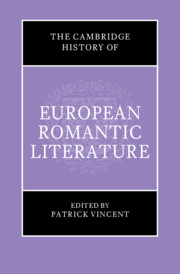Book contents
- The Cambridge History of European Romantic Literature
- The Cambridge History of European Romantic Literature
- Copyright page
- Contents
- Contributors
- Acknowledgements
- Note on the Text
- Chronology
- Introduction
- Part I Romantic Genealogies (1750–1790)
- 1 The Discovery of the Past
- 2 Discourses of Nature
- 3 The Romantic Sublime
- 4 Cultures of Sensibility
- 5 Gothic Circulations
- 6 The Crisis of Enlightenment
- Part II Revolution to Restoration (1790–1815)
- Part III Restoration to Revolution (1815–1850)
- Further Reading
- Index
1 - The Discovery of the Past
from Part I - Romantic Genealogies (1750–1790)
Published online by Cambridge University Press: 10 January 2024
- The Cambridge History of European Romantic Literature
- The Cambridge History of European Romantic Literature
- Copyright page
- Contents
- Contributors
- Acknowledgements
- Note on the Text
- Chronology
- Introduction
- Part I Romantic Genealogies (1750–1790)
- 1 The Discovery of the Past
- 2 Discourses of Nature
- 3 The Romantic Sublime
- 4 Cultures of Sensibility
- 5 Gothic Circulations
- 6 The Crisis of Enlightenment
- Part II Revolution to Restoration (1790–1815)
- Part III Restoration to Revolution (1815–1850)
- Further Reading
- Index
Summary
Chapter One shows how intersections between science and antiquarianism in the eighteenth century renewed Europeans’ awareness of the hidden depths of history. This re-discovery of deep time contributed to Romanticism’s modern, historicist consciousness by expanding the time scale, secularising and destabilising fixed chronologies, and providing writers with a rich array of source materials from pre-history, Classical and Eastern Antiquity, and the Middle Ages. Using late-Romantic poet Annette von Droste-Hülshoff’s’ ‘The Marl Pit’ as a guiding thread, it addresses Baron d’Hancarville’s archaeological work in Naples, the Comte de Buffon’s natural history, the Forsters’ travel accounts of their tour around the world, and early volumes of Herder’s Ideas Toward a Philosophy of the History of Humanity. The chapter then evokes the meeting in Rome of Nicolas Desmarest and J.J. Winckelmann to demonstrate how natural historians and antiquaries joined forces to understand the past. Contrasting William Blake’s imaginative interpretation of medieval history as a source of national identity with Horace Walpole’s sceptical view, it concludes by addressing the growing rift between a Romantic and more rigorously scientific apprehension of the past.
- Type
- Chapter
- Information
- The Cambridge History of European Romantic Literature , pp. 41 - 72Publisher: Cambridge University PressPrint publication year: 2023

